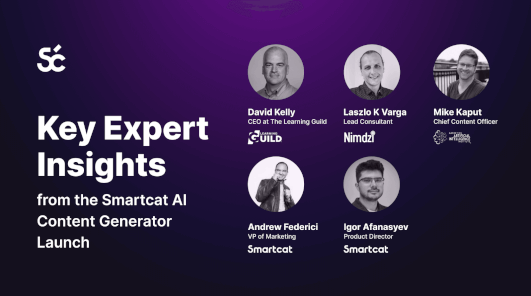Smartcat recently hosted an online launch event to present our all-new product, Smartcat AI Content Generator. Over 500 professionals from translation, L&D, marketing, and other industries were in attendance. If you missed it, you can watch the launch event recording.
During this event, we delved into some of the most cutting-edge topics in the realm of content creation and translation, exploring the remarkable capabilities of Smartcat AI. Our esteemed panel of industry experts, including David Kelly, CEO at the Learning Guild; Mike Kaput, CCO at Marketing AI Institute; Laszlo Varga, senior consultant at Nimdzi Insights; and Igor Afanasyev, director of product at Smartcat, engaged in a thought-provoking discussion. This panel shed light on how AI can revolutionize content generation, translation, and much more.
Mike Kaput – AI's transformative role in the marketing landscape
Mike Kaput, Chief Content Officer at the Marketing AI Institute, shared several key insights regarding the state of AI in marketing. His commentary highlighted the ongoing evolution of AI adoption in the marketing field, with a growing interest from both leadership and practitioners in leveraging AI technologies for improved marketing outcomes:
We’re still in the early stages of adoption
The average marketer is still in the early stages of adopting AI technology. Many businesses are trying to understand the practical applications and return on investment (ROI) of AI in their marketing efforts.
There’s a mindset shift in the industry
CEOs and CMOs are increasingly interested in exploring the possibilities of large language models and generative AI, marking a turning point in the industry's attitude towards AI.
Adoption varies across roles
Both executives and individual contributors are actively involved. According to a recent survey conducted by the Marketing AI Institute, about 98% of marketing leaders and practitioners are using AI tools in some capacity. This adoption spans across the organizational hierarchy, with executives integrating AI into workflows and practitioners conducting their own experiments.
Two types of adoption exist: bottom-up and top-down
The adoption of AI in marketing is not limited to either top-down or bottom-up approaches; it's happening from both directions simultaneously. Executives are actively seeking ways to incorporate AI into their strategies, while individual contributors experiment with AI tools independently. The goal is for these two approaches to converge and lead to the development of formal AI strategies, processes, policies, and guidelines within organizations.
Laszlo Varga – Assessing the present and future of AI in localization and language industry
Laszlo Varga, Lead Consultant at Nimdzi Insights, a localization and language industry research and consultancy company, underscored the cautious yet exploratory approach of the language industry towards large language models, with a focus on understanding their potential benefits and applications beyond translation.
Slow disruption across the entire language industry
While there's significant excitement around large language models, there still hasn’t been as much disruption in the language industry as in other sectors. This is to do with the fact that many large language models are general-purpose tools, not purpose-built for specific applications.
ROI and efficiency uncertainty remains
There’s ongoing uncertainty regarding the return on investment (ROI) and real efficiencies achieved with large language models, similar to the initial skepticism surrounding machine translation, which has since matured.
Use cases of LLM in the language industry
The primary use case for large language models in the language industry is translation. However, Laszlo emphasized that there are additional capabilities of large language models that go beyond translation and should not be overlooked. These capabilities are being explored and tested by various organizations.
We’re in the testing and vetting phase
Many organizations are currently in the testing phase, trying to determine the practicality and quality of using large language models. The unpredictability inherent in AI models presents a challenge in ensuring consistent quality.
Learning from the success of others
Laszlo highlighted the industry's interest in learning from others' experiences with large language models, seeking insights into their potential applications and benefits.
David Kelly – Exploring the challenges and opportunities of AI in learning and development
CEO at the Learning Guild, David Kelly, highlighted the current bottom-up approach to innovation in L&D, the unique challenges the field faces due to its cost perception, the emphasis on efficiency improvements, and the potential for top-down influence to drive future changes within L&D practices.
Bottom-up approach predominant in the L&D space
David emphasized that L&D is experiencing a bottom-up approach to adopting new technologies and practices. This means that individuals within organizations are taking the initiative to experiment with new L&D tools and approaches.
Challenging the perception of L&D
He noted a significant challenge faced by L&D in contrast to marketing. While marketing is often viewed as contributing to product sales, L&D is generally seen as a cost center in many organizations. Consequently, L&D needs to focus on improving efficiencies to demonstrate its value. One way to achieve this include demonstrating how AI can improve corporate learning KPIs, such as course development cost, employee learning engagement rates, and labor turnover.
The L&D industry must focus on efficiencies
The primary focus for L&D, according to David, is on enhancing efficiencies in training and development processes. This focus is expected to increase as L&D professionals explore ways to optimize their practices.
A top-down influence is soon to come
David anticipates that in the future, the pressure for efficiency and innovation within L&D will come from the top levels of organizations, including CEOs. As the adoption of new L&D practices and technologies becomes more normalized, senior executives will likely seek ways to improve the efficiency of their L&D groups.
Watch the official launch of the Smartcat AI content generator and listen to the captivating panel share their expert knowledge.
Book a 30-minute personalized demo to see the AI content generator in action.


